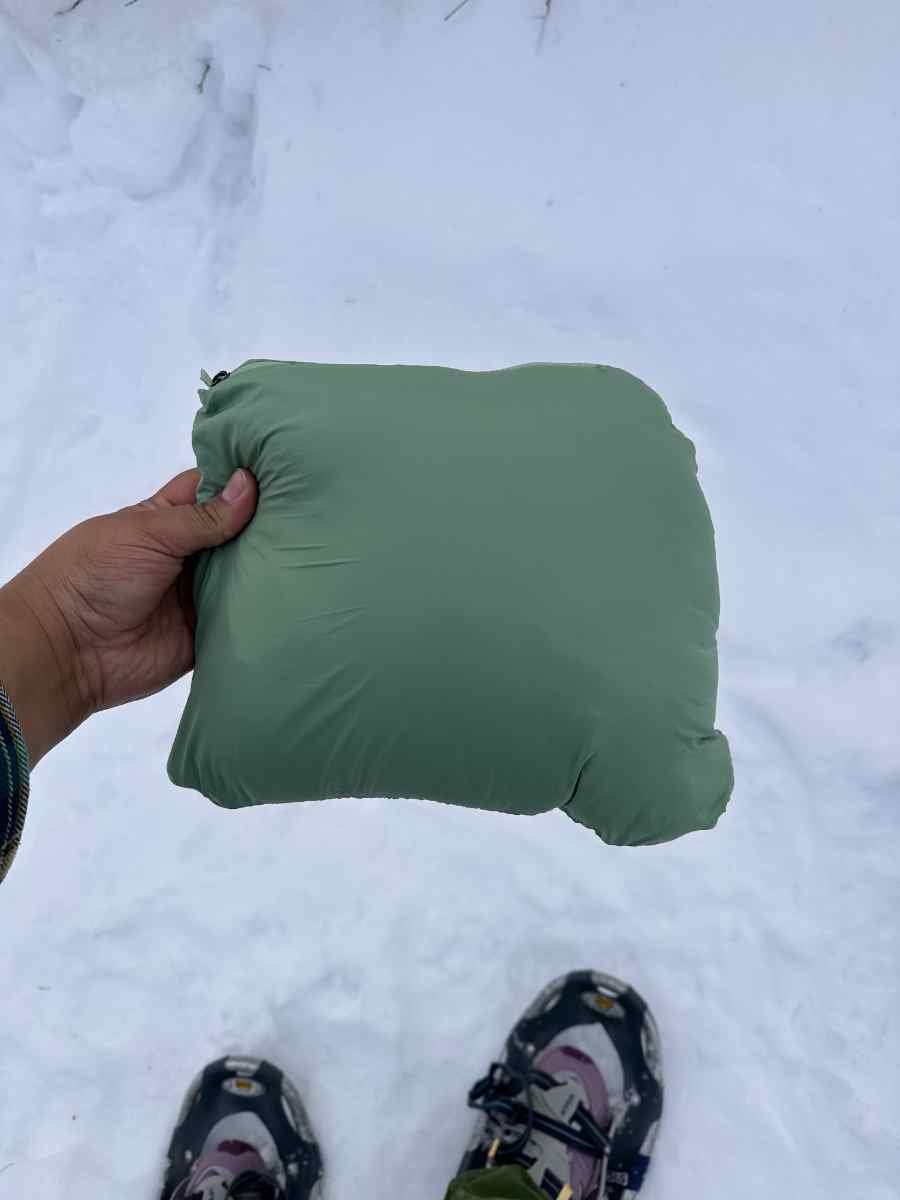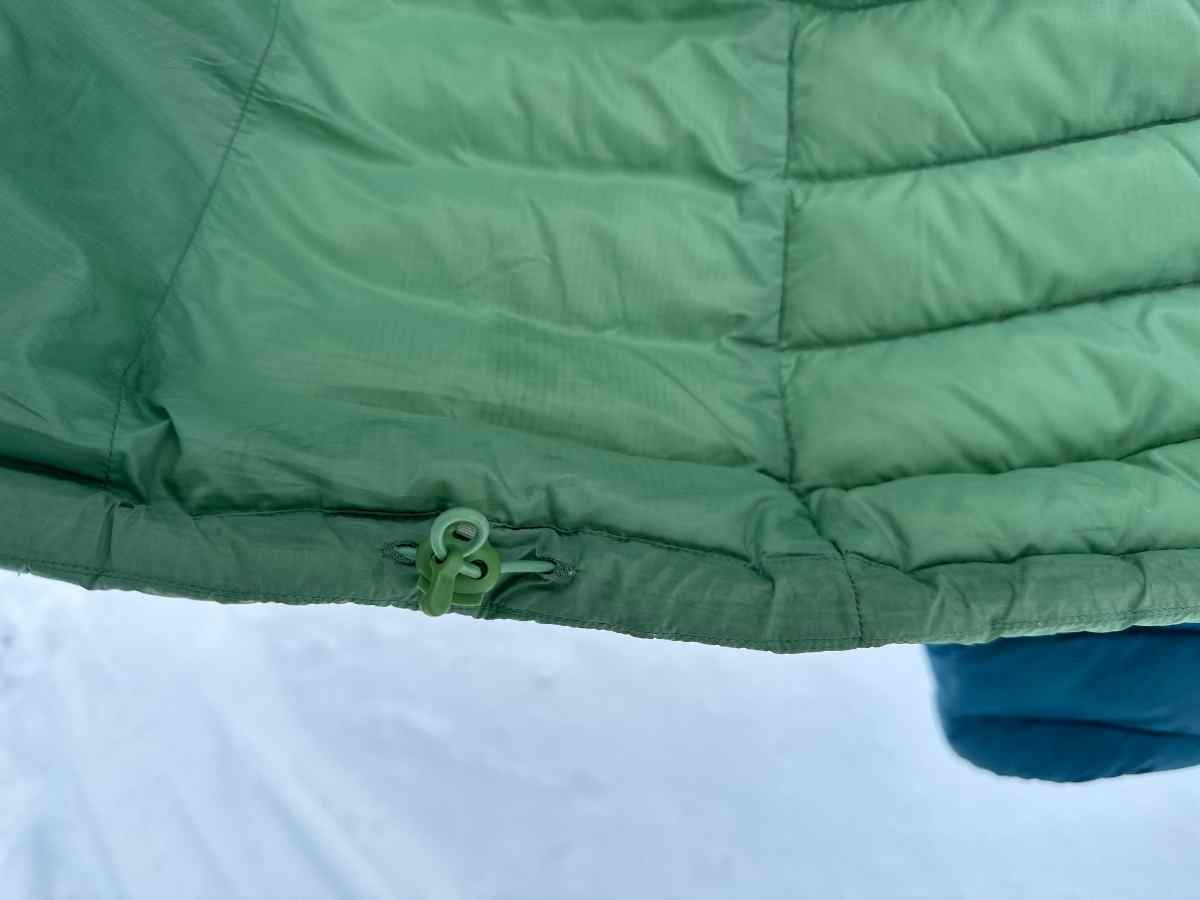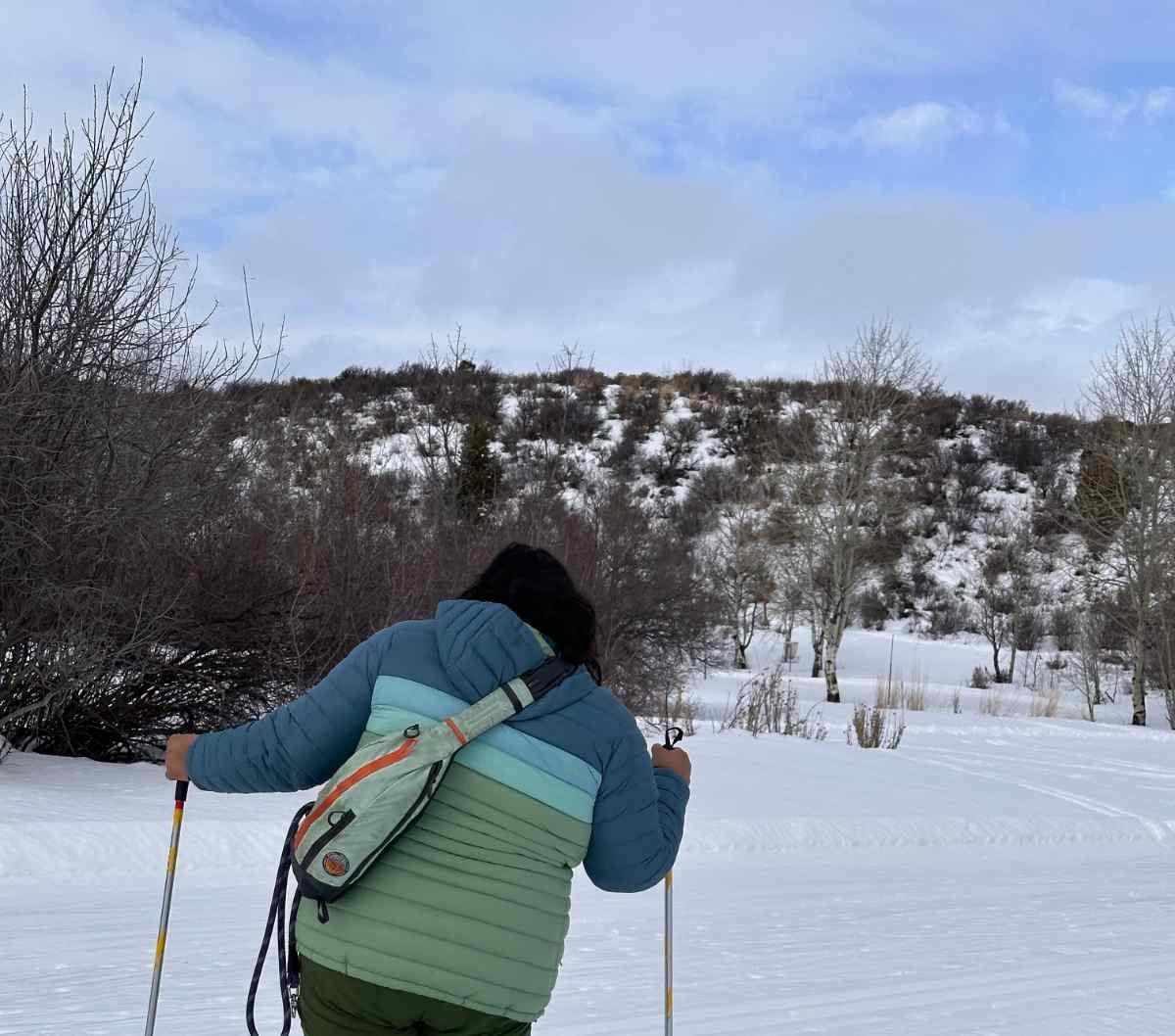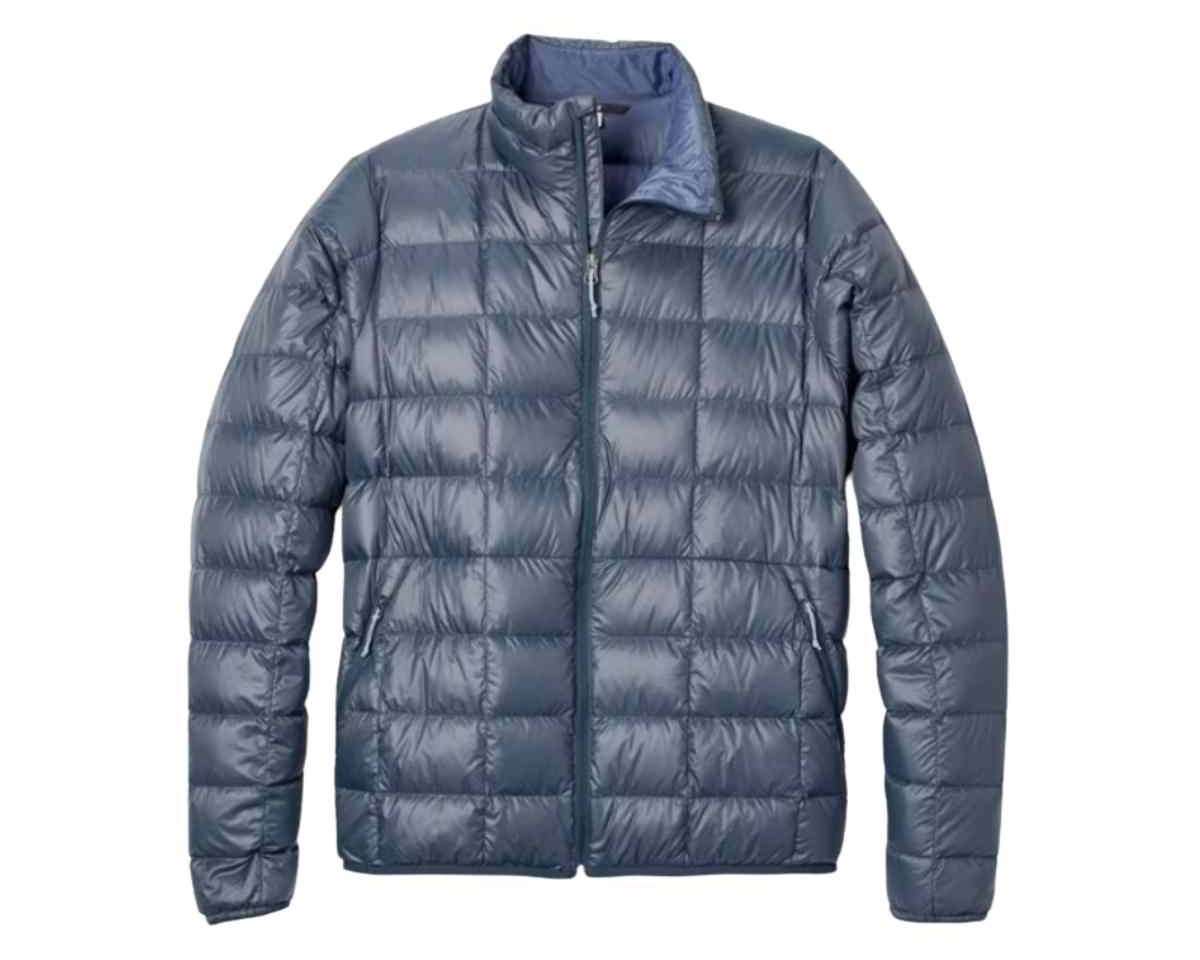Cotopaxi Fuego Down Jacket Review
Size-inclusive, practical, stylish, and environmentally conscious
Home > Gear Reviews > Apparel
Published February 6, 2024
OUR VERDICT
Stylish, trendy, and practical to boot, the Cotopaxi Fuego is an all-around down jacket that will carry you comfortably through three seasons and even into many winter conditions. I had long wanted to try out Cotopaxi’s apparel and never could prior to 2023, when the company debuted its expanded sizes offerings for “women’s” clothes, going up to a 4X. I tested the Cotopaxi Fuego down jacket during late November, December, and January throughout Idaho and Utah, taking it with me on hiking and snowshoeing adventures and as a daily usage jacket on my small homestead. The Fuego kept me comfortable as I fed livestock, baled hay, and spent time in cold and snowy conditions.
While it isn’t the warmest or most technical down jacket on the market, it is still a solid contender for most front and backcountry uses and will keep one warm throughout the majority of the year. With colorful designs, sustainable and ethical practices in creating the garments, and increased size inclusivity, the Fuego is a down jacket that I will turn to again and again.
We create reader-supported, objective gear reviews independently selected by our editors. This story may contain affiliate links, which help fund our website. When you click on the links to purchase gear, we may get a commission, without costing you an extra cent. Thank you for supporting our work and mission of outdoor coverage for every body! Learn more.
Cotopaxi Fuego Specifications
Price: $295 hooded, $270 non-hooded (often on sale)
Weight: 14 oz
Shell fabric: 100% 20D ripstop nylon with DWR finish
Insulation: Down
Hand warmer pockets: Zippered hand pockets
Internal pockets: Yes
Hood: Scuba hood (optional)
Available sizes: XXS-4X
Best for: Camping, hiking, everyday living
WOMEN'S
MEN'S
WHAT WE LIKED
Trendy and cute colorway options
Lightweight
Packable
Versatile
WHAT WE DIDN’T LIKE
Lacking adjustable features at the cuffs and hood
Not as warm as expected for the price point
Slightly more delicate/prone to rips in the shell fabric than similar jackets
COMPARE THE FUEGO
WOMEN’S
| WOMEN'S DOWN JACKET | SIZES | CATEGORY | ETHICALLY SOURCED DOWN | TOTAL WEIGHT (oz) | FILL POWER | HYDRO PHOBIC DOWN? | NUMBER OF POCKETS | MSRP* |
|---|---|---|---|---|---|---|---|---|
| Cotopaxi Fuego Down Jacket | XXS-4X | Midweight | RDS | 14 | 800 | Yes | 4 | 270 |
| Cotopaxi Fuego Hooded Down Jacket | XXS-4X | Midweight | RDS | 14 | 800 | Yes | 4 | 295 |
| Patagonia Down Sweater | XXS-XXL | Lightweight | Traceable Down + bluesign | 10.3 | 800 | No | 3 | 279 |
| REI Co-op 650 Down Jacket | XS-3X | Lightweight | RDS | 10.2 | 650 | No | 2 | 129 |
| Outdoor Research Helium Down Hoodie | XS-4X | Midweight | RDS | 15.4 | 800 | No | 5 | 299 |
MEN’S
| MEN'S DOWN JACKET | SIZES | CATEGORY | ETHICALLY SOURCED DOWN | TOTAL WEIGHT (oz) | FILL POWER | HYDRO PHOBIC DOWN? | NUMBER OF POCKETS | MSRP* |
|---|---|---|---|---|---|---|---|---|
| Cotopaxi Fuego Down Jacket | XS-XXXL | Lightweight | RDS | 11 | 800 | Yes | 4 | 270 |
| Cotopaxi Fuego Hooded Down Jacket | XS-XXXL | Light- to Midweight | RDS | 14 | 800 | Yes | 4 | 295 |
| Patagonia Down Sweater | XXS-3XL | Lightweight | Traceable Down + bluesign | 13 | 800 | No | 3 | 279 |
| REI Co-op 650 Down Jacket | S-XXXL | Lightweight | RDS | 10.9 | 650 | No | 2 | 129 |
| Outdoor Research Helium Down Hoodie | S-XXXL | Midweight | RDS | 16.2 | 800 | No | 5 | 299 |
HOW WE TESTED
Testing the Fuego’s warmth on an 8 mile hike in the Caribou National Forest. Photo by Clayne Zollinger
Working outside with livestock, in temps ranging from 5°-30°
Hiking
Snowshoeing
Everyday living in Southern Idaho and Salt Lake City, UT
FEATURES
SHELL FABRIC
The ripstop nylon shell is fairly sturdy, withstanding the daily work demands of maintaining a homestead, as well as weekend hiking and snowshoeing trips. I did find a few knicks and abrasions on the chest and arms after a month of daily wear, so although I find the nylon ripstop shell generally durable, I would likely not wear it during more punishing backpacking trips where I may brush against lots of boulders or trees. The shell feels more delicate than other down jackets I own, such as the Outdoor Research Helium Down Hoodie. Though, at 15.4 ounces, the Helium is heavier than the Cotopaxi.
The nylon is 100% 20D ripstop nylon with DWR finish, or a Durable Waterproof Finish. This finish is intended to prevent moisture from saturating the interior of the jacket. It’s important to keep in mind that the Fuego has down insulation, so the jacket itself is not 100% waterproof, nor is it intended to replace a waterproof layer. Still, I walked and hiked in the Fuego during snowy conditions for short periods of time (less than half an hour) and experienced no wet or cold spots inside the jacket. This experience makes me feel confident about the water resistance of the shell, and I can see myself using it with confidence in snowy weather for shorter periods of time.
INSULATION
The Fuego is insulated with 800-fill responsibly sourced goose down that provided me with suitable warmth in temperatures in the single digits (with a fleece and base layer underneath). Cotopaxi doesn’t provide the fill weight of the down in their jackets, but I generally found it comparable to other lightweight down jackets I have tried. That being said, when deciding which jacket based on warmth, it would be helpful to know amount of down that Cotopaxi is using.
Even in the lightly falling snow, the jacket did not lose loft nor feel heavy, thanks to the water-resistant downfill. For a three season jacket, which I find to be its best use, the insulation feels lightweight and warm.
FRONT ZIPPER
The dual string front zipper with elastic ends is a comfortable and easy zipper to use. Photo by Gabi Reyes-Acosta
I can be picky about zippers, as I hate spending time being careful with zipping my jacket on and off, especially as I run out the door to eagerly hit the trail or do yard work. The zipper is large enough for me, with two small rubberized ends about half an inch long that make absentmindedly grabbing the zipper to close or open the jacket easy to do.
I greatly enjoyed how high the zipper goes–up to the chin – which made it simple to protect and keep my neck warm in cold conditions. A smooth zipper that doesn’t take a second thought is the best kind of zipper, and the Fuego’s front zipper does just that.
POCKETS
For me, there are plenty of pockets on the Fuego for the items I keep closest to me on a hike: my phone, chapstick, and gloves. There are two internal pockets: one zippered and one non-zippered. The internal pockets are dual-purpose, as the jacket can be packed and enclosed in the zippered pocket when stored for travel. They can also store items comfortably while being worn. Inside the zippered pocket, I stashed my iPhone 14 Pro, car keys, and dog bags with room to spare.
The external pockets are also deep, accommodating my large hands comfortably. Overall, the Fuego’s pockets are functional and large enough for my most used items while on a day hike.
PACKABILITY
A prime feature of the Fuego is its packability, displayed while being stored away on a hike. Photo by Gabi Reyes-Acosta
The Fuego is the most packable down jacket I own. It folds fairly easily into the internal zippered pocket. The pocket gets turned inside out for the jacket to fit inside, and once I understood how it worked, it was extremely simple.
When snowshoeing on a warm, 35° day, I loved knowing I could shed the jacket, pack it away in its own pocket, and stash it in my day pack. On a summer or early fall backpacking trip, which are the ideal conditions for this jacket’s use while backpacking (it’s not warm enough for winter backpacking), I know this feature will be very useful for storing the jacket while I’m not using it.
In general, with pieces of gear made with down, it’s best practice to leave an item out of its stuff sack for storage. If it is packed/compressed for long periods of time, the gear can be damaged from long-term compression. In the relatively short times I’ve had the jacket packed in itself, I’ve been impressed with how lofty it still looks after being unpacked.
CUFFS
I am a big fan of a good pair of cuffs on a jacket or sweater, and am generally pleased with the Fuego’s cuffs. However, I wish it had more features, like thumb loops, adjustable drawstrings, or velcro.
The Fuego has well-made elastic cuffs that mirror the elastic around the hood. The cuffs didn’t roll up or result in cold wrists as I walked and hiked around, which is a feature that I’m always thankful for. As someone with long arms, I often suffer when wearing feather jackets with shorter sleeves that leave my wrists exposed. That is not the case with the Fuego.
DRAWCORD HEM
Gabi testing out the drawcord hem of the Fuego. Photo by Gabi Reyes-Acosta
I liked the drawcord hem of the Fuego. When fully cinched, the jacket felt secure around my hips. I’m tall with a fairly long torso and didn’t findrides up as I raise my arms and move around.
HOOD
The Fuego’s hood, like the cuffs, was perfectly functional, even if it left me wishing for more adjustable features. It fit securely around my head but did get in the way of my glasses a few times when I moved quickly or bent over for long periods of time, which does not happen on other down jackets that feature adjustable hoods. An adjustable drawcord would prevent this, so hopefully future iterations of the Fuego include a feature like this.
Overall though, the hood was large enough to accommodate a beanie, cap, and the hood of other layers beneath it, and I found it useful and not too intrusive as I moved around.
WARMTH
A closer look at the inside of the drawcord hem while on a snowshoe hike. Photo by Gabi Reyes-Acosta
The Fuego is not the warmest down jacket I own, nor would I recommend it for four-season use. This does not mean that the Fuego would be a mistake to choose, as a down jacket that is excessively warm can cause overheating. I found it perfectly warm in temps down the teens, especially when paired with a base layer and a warm fleece, which is the best course of action when spending time outdoors since layers are the safest way to ensure that you don’t overheat and can shed clothing as needed.
I most recently tested the Fuego on a snowshoe hike in the Caribou National Forest in Idaho, and although it was a cloudy mid-30° day I stayed warm as long as the jacket was on.
For daily use, I found the hood and high neck helped retain warmth even when I fed livestock during 15° days. Because of its easy-to-use zipper and light weight, it was convenient to throw on as I ran out the door into the cold.
The warmth-to-weight ratio of the Fuego is serviceable, in my opinion, as the jacket is light and packable while being warm for most seasons and conditions with the exception of heavy snow and wind. The L.L.Bean Ultralight 850 and the Outdoor Research Helium jackets are similar in weight and warmth but feel more windproof and consistently warm without overheating.
WIND AND WATER PROTECTION
The Cotopaxi Fuego Down Jacket has strong seams, here’s an up close image of that. Photo by Gabi Reyes-Acosta
Speaking of wind, the Fuego is also not the most windproof jacket I own, and I found myself wishing that it provided more wind protection than it did. Southern Idaho, where I live, is very windy, and on cold days, the wind chill feels biting even through this jacket.
If layered with a warm, windproof layer, like the Women’s Trail Mix Cowl Pullover from Outdoor Research, I didn't notice the wind chill as much. In my other down jackets, though, I don’t need another layer to prevent feeling the wind (mostly in wind speeds that aren’t above 15 mph). I wish that were the case with the Fuego. Feeling the windchill is also avoidable if one were to use the Fuego in milder conditions, which I think it’s best suited for.
As for water protection, the Fuego is a down jacket and thus will never be my first option in a downpour as a waterproof layer is always best. Down insulation can get wet more easily and dries out more slowly, making it not ideal in wet and very snowy conditions.
I did wear the Fuego while on a hike that culminated in a waterfall. I stood behind the falls for about twenty minutes, where the mist from the falls was strong, and the air was extremely damp. I did not find any wet spots or get cold or damp, so I feel comfortable with how the Fuego performs in damp and wet conditions for a short amount of time. I also wore the Fuego walking in moderately falling snow for increments of no more than half an hour. Again, I did not find damp spots. I would generally recommend that the Fuego not be worn if wet weather is predicted, but for accidental snow storms, light rain, and damp, I think it does a more than adequate job.
FIT AND SIZING
I was really impressed at the fit of Cotopaxi’s Fuego. Where most outdoor companies offer extended and plus sizing tops out at 2X or 3X, Cotopaxi goes up to a 4X. The size I tested, a 3X, felt roomy and had room to layer.
In my everyday clothing I tend to wear a 20/22 or a 2X, but I often size up to 3X in clothing made by outdoor companies as I’ve found that they tend to run small. Unlike other 3X’s I own, like the Outdoor Research Helium Jacket, the Cotopaxi 3X felt so comfortable I could probably size down to my truer size, which is new for me when trying outerwear made by outdoor apparel companies.
I would advise trying on the Cotopaxi extended sizes if possible or using their size chart with your measurements in mind to see where you best fit. Although I do think I could size down, I’m very happy with the 3X, as I’m able to layer underneath. At one point, I was wearing a merino wool baselayer, a flannel, and a fleece underneath the Fuego, and I didn’t feel any constriction. This is refreshing, as many outdoor companies do not make 3X sizing that feels as spacious as the Fuego.
It’s important to note that Cotopaxi’s extended sizing does not cover their entire line of gear nor “men’s” sizing, so those who purchase men’s sizing will find that their sizes top out at XXXL.
VALUE
Prior to 2023, I could not purchase Cotopaxi apparel because I was too large for their size offerings. I also was not a customer because of the price point, which felt inaccessible when I was in younger years of adventuring outdoors and didn’t have much money to spare on gear.
The Fuego is $295, which is still a high price point, but is comparable to other hooded jackets in its class, like the OR Helium Hoodie, which sits at $299. For the packability, weight, and excellent fit, I think the Fuego is an overall good value, especially because Cotopaxi often can be purchased on sale at retailers like REI during yearly sales and on Cotopaxi’s site itself. I’m a bargain hunter, so I personally would be waiting for sales periods to purchase the Fuego, but I do think that buying it at full price would not be a bad value.
I have tested and heavily used the Fuego in daily outdoor tasks, hikes, and snowshoeing trips. My testing has been heavy and tough on the jacket, and I find it’s held up to my use without losing feathers, ripping, or fading. The Fuego has been rubbed against muddy hay bales and pressed against livestock animals without losing color or retaining the dirt once cleaned.
As I have aged and become stronger in my values surrounding the sources of my gear and apparel, I also find the value of the jacket to be worth it when I consider the working conditions of those who made the Fuego and the animals whose feathers fill the insulation. I know now in ways that I didn’t when I was younger and searching for the cheapest piece of gear, that apparel made with care for the environment and the living beings who create it comes with a slightly higher price tag – a price tag I am happy to pay.
ENVIRONMENTAL AND SOCIAL IMPACT
Testing the Fuego’s warmth on an 8 mile hike in the Caribou National Forest. Photo by Clayne Zollinger
RDS-CERTIFIED DOWN
Emblazoned on the back of the Fuego is the slogan “Gear for Good,” and Cotopaxi’s business practices seem to align with that slogan. The down used in the Fuego, and in all of Cotopaxi’s down items, is “responsibly sourced and processed in partnership with ALLIED Feather + Down” according to Cotopaxi’s site. This means that the supply chain is audited and transparent, and that 100% of the down they use comes as a byproduct of the food industry, and the ducks and geese used are being treated in accordance with Brambell’s five freedoms of animal welfare. According to ALLIED, these freedoms include: freedom from hunger and thirst, discomfort, pain, injury, and disease, and fear and distress. It also means that the waterfowl used are allowed to express normal behavior.
As an animal lover, and one who works with birds on my own homestead, I was relieved to know that Cotopaxi works with ALLIED to ensure that the down that is in their products comes from birds that lived generally healthy and humane lives. Additionally, by using proprietary environmentally friendly processing, the down insulation has a more minimal impact on the planet than traditionally made down products. For those who prefer to use products with the use of down fill, Cotopaxi makes a similar insulated jacket, the Capa. The Capa uses synthetic insulation, but unlike the Fuego only the “Drizzle/Aspen” color goes up to a size 4X.
FAIR TRADE
I also value knowing that not only are the animals used in creating a product I am using are treated humanely, but that the humans who create and produce the gear are also able to live and thrive safely in their work. A Fair Trade Certified B-Corp, Cotopaxi works with transparently audited factories to ensure that workers are treated fairly. In a move I have never seen on a gear company’s website, I can even learn about the factory that produced the Fuego. I learned that the Tianjin Factory in Tianjin, China, provides free lunches, a transportation program, and an organic garden for its workers.
RECYCLED FABRIC
In other sustainability practices, Cotopaxi provides lifetime warranties and repairs for its gear, and aims to use recycled, repurposed, or responsibly sourced materials in all of their products by 2025.
PFAC AND PFAS CHEMICALS
Since Cotopaxi uses remnant fabrics, they don't know whether their products are PFAC- and PFA-free. You can read more about their commitment to removing such chemicals here. You can read more about why it matters here.
CARE AND MAINTENANCE
I found the Fuego easy to clean and the shell fairly stain resistant. I simply wiped away most stains with my hand or an available towel. Although I have not yet had to wash the Fuego, I feel comfortable doing so, especially with Cotopaxi's comprehensive instructions on caring for its down items. In general, washing gear and apparel with insulation only a few times per year – with down wash on a gentle cycle and monitoring the jacket as it goes through a low-heat drying cycle – is the best way to ensure that it gets cleaned without damaging the insulation. Read more about how to care for your down jacket here.
With minimal feather loss and a rip-stop shell that can withstand most conditions, I don’t foresee having to repair or maintain the Fuego’s shell, and will use a patch should a small tear happen, like a NoSo patch.
WHERE TO FIND A DEAL
Retailers like REI, Moosejaw, and Steep and Cheap have Cotopaxi items on sale regularly, and I’ve seen the Fuego go as low as $200. As of Februrary 2025, the Fuego can be purchased on REI’s website for $205, a great value for an 800-fill down jacket.
Since extended sizing at Cotopaxi is fairly recent, I haven’t been able to consistently find the extended sizes (1-4X) in stock and on sale at retailers like Moosejaw and Steep and Cheap. This could also be due to retailers not purchasing those sizes from Cotopaxi, which I hope to see change so that more people can access the larger sizes.
WHAT COULD BE BETTER
While I give lots of praise to the packability and sustainability of the Fuego, I think it lacks features that could make the jacket more technical for outdoor activities like backpacking. Adjustable cuffs, thumb loops, an adjustable hood, and vents would be features that I would like to see added to the Fuego, and would be the deciding factor between me bringing it on a summer backpacking trip or choosing a competitor.
I also wish I knew the fill weight of the Fuego, which isn’t listed on Cotopaxi’s website. I don’t find the Fuego to be the warmest down jacket in its class and knowing the fill weight would likely confirm my thoughts surrounding warmth–namely that the jacket could be warmer.
WARRANTY
Cotopaxi offers a lifetime repair warranty, meaning that they will repair any item that has been affected “by a manufacturing defect for the lifetime of the product,” which Cotopaxi defines not as a specific period of time but as an estimate that they base on how well the item would be realistically functional. This might mean replacing items like malfunctioning zippers, snaps, or buttons that no longer close. This does NOT include wear and tear caused by rips, pinholes, accidental damage, or peeling logos.
Claims can be filed online or in a Cotopaxi store. I find this warranty to be fairly standard, but I do wish it was more generous. For example, Darn Tough’s warranty, replaces socks with holes worn in them from standard usage and seems to be open to considering most claims with the exception of loss, theft, animals eating them, or being burned. I foresee my biggest repair needs to be centered around rips and knicks in the shell, which would not be covered by Cotopaxi’s repair warranty.
WHO ELSE LIKES IT
The Fuego is a popular jacket, and a stroll through nearly any mountain town in the West can attest to that. Besides being very visible due to its colorful design, the Fuego is loved by many reviewers and adventurers. On REI’s website, over 1,300 customers have given it an average of 4.6 rating out of 5. On Outdoor Gear Lab, the women’s Fuego was given a 4.1 rating and ranked 9 out of 14 in their reviews on down jackets for women. The Outbound’s review of the Fuego rates it at a 4.3, echoing my own favorable reviews of the jacket’s packability and comfort.
Where to buy the Cotopaxi Fuego
The Cotopaxi Fuego are popular, so you have options when it comes to retailers. Here are some of the pros of the retailers.
REI
Pros: 100% satisfaction policy for 1 year; 10% dividend for members.
Amazon
Pros: Free 2-day shipping with Amazon Prime membership
Advice on where to buy
In general for jackets, we recommend purchasing from a place with easy or free returns like REI or Zappos. Trying on jackets is an important way to get the sizing right. With both those retailers, if your funds allow, you can buy two sizes and easily return one. Additionally, you can check reviews to see whether other users recommend sizing up or down.
OTHER DOWN JACKETS TO CONSIDER
PATAGONIA DOWN SWEATER
Price: $279 for the jacket, $329 for the hoody
Weight: 10.3 and 12.1 oz (women’s); 13.0 and 14.8 oz (men’s)
Shell fabric: 1.2-oz 20-denier NetPlus® 100% post-consumer recycled nylon downproof ripstop made from recycled fishing nets to help reduce ocean plastic pollution; with a PFC-free DWR finish (durable water repellent coating that does not contain perfluorinated chemicals)
Insulation: 800 fill RDW Down
Hand warmer pockets: two zippered
Internal pockets: 1 zippered chest pocket, 2 drop-in pockets
Hood: Optional
Available sizes: Women's XXS-XXL Men’s XXS-XXXL (not size inclusive)
Best for: Backcountry and frontcountry hiking, backpacking, and other dry weather outdoor conditions
The Patagonia Down Sweater is comparable to the Fuego in price point and sustainability practices as both Patagonia and Cotopaxi are companies that are focused on creating products with the planet and people in mind. They both have 800 fill down and reviews of the Patagonia lean towards the jacket being slightly warmer and more windproof. I also appreciate that the Patagonia Down Sweater features an adjustable drawcord at the back of the hood, making for a more customized fit on the hood.
The biggest difference between the Fuego and Patagonia’s down jacket is size inclusion: Patagonia does not offer extended sizes/plus sizes in its clothes and only goes up to an XXL, which I find to run small from personal experience trying on the jacket in store.
REI Co-op 650 DOWN JACKET
Price: $129
Weight: 10.2 oz (women’s), 10.9 oz (men’s)
Shell fabric: Recycled Rip-Stop Nylon (bluesign approved)
Insulation: 650 Fill RDS Down
Hand warmer pockets: Zippered
Internal pockets: 2 drop-in pockets
Hood: Yes, but only in the parka length for women and in the men’s version
Available sizes: Women’s XS-3XL, Men’s S-3XL
Best for: Frontcountry usage, car camping, short backpacking trips, everyday usage in town
The REI 650 Down Jacket is a great option for one looking to purchase their first lightweight down jacket that is sustainably made. The price point is lower than the Fuego and REI Co-op members can often get it even cheaper during sales and with member coupons. I’ve found the REI 650 jacket to perform well in all seasons especially when layered correctly with base and mid layers. Additionally, I did find it slightly more durable than the Fuego, as I’ve had this jacket for almost two years and have found very little feather loss and no nicks or tears in the fabric. Sizewise, they are different in that the Fuego goes up to a 4X while the REI jacket only goes to a 3X.
OUTDOOR RESEARCH HELIUM DOWN HOODIE
Price: $299
Weight: 18 oz (women’s plus sizes) and 15.4 oz (women’s non-plus sizes)
Shell fabric: Pertex Quantum 30-denier ripstop nylon (bluesign certified)
Insulation: 800 fill RDS down
Hand warmer pockets: two zippered
Internal pockets: Dual internal stash pockets
Hood: Yes
Available sizes: Women’s XS-4XL, Men’s S-XXXL
Best for: Backcountry and frontcountry usage
OR’s Helium is my favorite and most used piece of gear, next to the Coldfront which is also from OR but is much less packable and heavier. The Helium does have a slightly more snug fit at the 3X than the Cotopaxi does in the same size, but I find its insulation to be more wind and chill proof than the Fuego. Both jackets are also extremely packable but the Helium is a few ounces heavier in the plus sizes, which is important for those who are counting ounces on the trail. While the Fuego and the Helium are very similar, I tend to prefer the Helium for its consistent warmth and durability.
Mountain Hardwear Ghost Whisperer Down Jacket
Price: $329 (non-hooded option) or $359 (with hood)
Weight: 7.8 oz (women’s non-hooded) or 8.5 oz (women’s hooded)
Shell Fabric: recycled
Insulation: 800-fill-power Responsible Down Standard (RDS) goose down
Hood: Yes; comes in either hooded or non-hooded
Pockets: yes; 2
Available sizes: XS-2XL (men’s) or XS-XL (women’s)
Best for: Ultralight hikers or campers who want warm but light
A packable, ultralight and feature-packed jacket for its size, the Mountain Hardwear Ghost Whisperer is one of our top choices for down warmth for three-season conditions.
An ultralight classic, the Ghost Whisperer is best for those looking for something more than the basics, while still shaving weight. It has two side pockets, an adjustable hem cinch, an optional hood, and 800-fill goose down and recycled shell fabric. It comes in sizes up to 2XL (for men). And we hope to see even more sizes added in the future given the popularity of this jacket.
ABOUT THE AUTHOR / WHY YOU SHOULD TRUST US
I have been venturing outside to hike, backpack, snowshoe, ski, and a dozen uses in between for my entire adult life. As a plus-size outdoors person, I value testing and recommending gear that fits more bodies than what outdoor brands and companies have traditionally seen as their customer base, and I’m passionate about showing the world that the outdoors is for everyone. This starts with clothing and gear made to fit a variety of different body shapes. There is so much work to be done on making more brands accessible in terms of size inclusion, but I am excited about what’s been done and the moves that companies will make in the future to reach out to people who need comfortable and safe gear to allow them to get outside.
I tested the Fuego in the ways I will use it throughout the year– keeping me warm while running errands in town, working on my small homestead in the Mountain West, and hiking and snowshoeing in the nearby National Forests. I plan to continue testing this jacket during backpacking trips in the summer as well.
I review gear to answer the questions I have when I’m looking to purchase and invest in an item: will it fit me? Will it keep me comfortable and safe in the conditions it’s suitable for? And, will it fit others in my community? These questions keep me as reviewer and lover of nature centered as I test gear.
I know what it feels like to not find items to fit and to not be able to do the things I want to do, and I hope that reviews like this will help readers not have to be like I once was: stuck in an aisle in an outdoor store and unsure what, if anything, would fit my body.
Gabi Reyes-Acosta is a frequent contributing writer for Treeline Review, and you can find their full bio here.



















